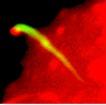Although microtubule-based vesicle trafficking has dominated the field, there is emerging evidence that actin is also involved in endocytosis and exocytosis.
We recently identified a novel mechanism by which actin propels membrane vesicles. Overexpression of PIP5K induces the formation of actin "comet tails," which propel vesicles enriched in lipid rafts. Listeria, an intracellular pathogen, hijacks this machinery to infect cells.
PIP2-induced comet formation is coordinated by actin regulatory proteins (such as the WASP: Arp2/3 complexes and actin depolymerizing factor/cofilin), tyrosine kinases, and small G-proteins.
We are studying how these molecules work together to generate comets and defining how actin contributes to vesicle traffic.
 Actin comit (red) stained with anti-phosphotyrinase antibody
Actin comit (red) stained with anti-phosphotyrinase antibody
Cell microinjected with GFP-actin and PIP5K vectors. Images filmed 2 hrs. post-injection. The frames are approximately 60 µm wide and taken at 20 sec. intervals.